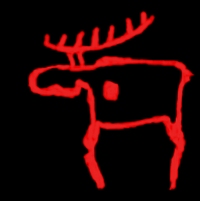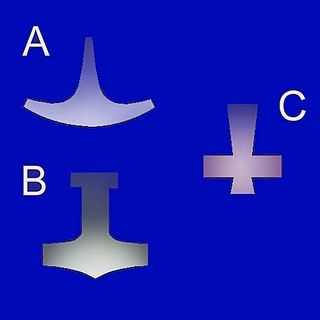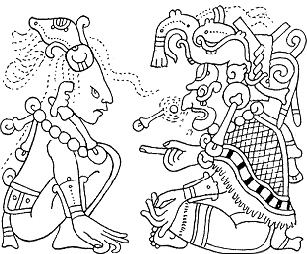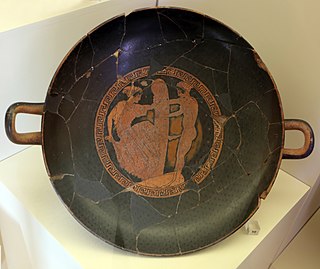
Tláloc is the god of rain in Aztec religion. He was also a deity of earthly fertility and water, worshipped as a giver of life and sustenance. This came to be due to many rituals, and sacrifices that were held in his name. He was feared, but not maliciously, for his power over hail, thunder, lightning, and even rain. He is also associated with caves, springs, and mountains, most specifically the sacred mountain where he was believed to reside. Cerro Tláloc is very important in understanding how rituals surrounding this deity played out. His followers were one of the oldest and most universal in ancient Mexico.

Mikael Agricola was a Finnish Lutheran clergyman who became the de facto founder of literary Finnish and a prominent proponent of the Protestant Reformation in Sweden, including Finland, which was a Swedish territory at the time. He is often called the "father of literary Finnish".

Ukko, Äijä or Äijö, parallel to Uku in Estonian mythology, is the god of the sky, weather, harvest, and thunder across Finnic paganism.

Midsummer is a celebration of the season of summer, taking place on or near the date of the summer solstice in the Northern Hemisphere; the longest day of the year. The name "midsummer" mainly refers to summer solstice festivals of European origin, especially those in the Nordic countries. In these cultures it is traditionally regarded as the middle of summer, with the season beginning on May Day. Although the summer solstice falls on 20, 21 or 22 June in the Northern Hemisphere, it was traditionally reckoned to fall on 23–24 June in much of Europe. In Christian tradition, these dates coincide with Saint John's Eve and Saint John's Day. It is usually celebrated with outdoor gatherings that include bonfires and feasting.
Finnish mythology commonly refers of the folklore of Finnish paganism, of which a modern revival is practiced by a small percentage of the Finnish people. It has many shared features with Estonian and other Finnic mythologies, but also with neighbouring Baltic, Slavic and, to a lesser extent, Norse mythologies.
Peijaiset is a Finnish concept, dating to pre-Christian times, denoting a memorial feast that was held to honour a slain animal, particularly the bear, the animal most sacred to ancient Finns. In modern-day usage, it often refers to the celebrations following a successful elk hunt, or a feast at the end of a hunting season. It may also be used in a figurative sense, denoting any memorial held for things that have come to an end. Traditionally, it referred to wakes for humans and animals, but also other celebrations, depending on the region in question.
Festivals in ancient Rome were a very important part in Roman religious life during both the Republican and Imperial eras, and one of the primary features of the Roman calendar. Feriae were either public (publicae) or private (privatae). State holidays were celebrated by the Roman people and received public funding. Games (ludi), such as the Ludi Apollinares, were not technically feriae, but the days on which they were celebrated were dies festi, holidays in the modern sense of days off work. Although feriae were paid for by the state, ludi were often funded by wealthy individuals. Feriae privatae were holidays celebrated in honor of private individuals or by families. This article deals only with public holidays, including rites celebrated by the state priests of Rome at temples, as well as celebrations by neighborhoods, families, and friends held simultaneously throughout Rome.

The Temple at Uppsala was a religious center in the ancient Norse religion once located at what is now Gamla Uppsala, Sweden attested in Adam of Bremen's 11th-century work Gesta Hammaburgensis ecclesiae pontificum and in Heimskringla, written by Snorri Sturluson in the 13th century. Theories have been proposed about the implications of the descriptions of the temple and the findings of the archaeological excavations in the area, along with recent findings of extensive wooden structures and log lines that may have played a supporting role to activities at the site, including ritual sacrifice. The temple was destroyed by King Inge the Elder in the 1080s.

Baltic Finnic paganism, or BalticFinnic polytheism was the indigenous religion of the various of the Baltic Finnic peoples, specifically the Finns, Karelians, Estonians, Vepsians and Izhorians, prior to Christianisation. It was a polytheistic religion, worshipping a number of different deities. The chief deity was the god of thunder and the sky, Ukko; other important deities included Jumala, Ahti, and Tapio. Jumala was a sky god; today, the word "Jumala" refers to a monotheistic God. Ahti was a god of the sea, waters and fish. Tapio was the god of the forest and hunting.
Taara, also known as Uku or Jumal, is a prominent god in Estonian mythology, with a strong resemblance to the Finnish Ukko and the Germanic Thor.
Estonian mythology is a complex of myths belonging to the Estonian folk heritage and literary mythology. Information about the pre-Christian and medieval Estonian mythology is scattered in historical chronicles, travellers' accounts and in ecclesiastical registers. Systematic recordings of Estonian folklore started in the 19th century. Pre-Christian Estonian deities may have included a god known as Jumal or Taevataat in Estonian, corresponding to Jumala in Finnish, and Jumo in Mari.

Modern Finnish paganism, also known as Finnish neopaganism or the Finnish native faith, is the contemporary revival of Finnish paganism, the pre-Christian polytheistic ethnic religion of the Finns. A precursor movement was the Ukonusko of the early 20th century. The main problem in the revival of Finnish paganism is the nature of pre-Christian Finnish culture, which relied on oral tradition which may be subject to change over time. The primary sources concerning Finnish native culture are written by latter-era Christians.
Rauni is a name for a being in Finnish mythology. The exact role and identity of Rauni is debated, and theories range from Rauni having been a mother goddess and consort of Ukko to being identified with Ukko himself.

Ukonvasara, or Ukonkirves, is the symbol and magical weapon of the Finnish thunder god Ukko, similar to Thor's Mjölnir. Ukonvasara means 'hammer of Ukko'; similarly, Ukonkirves means 'axe of Ukko'. It was said that Ukko created lightning with Ukonvasara.
Profane, or profanity in religious use may refer to a lack of respect for things that are held to be sacred, which implies anything inspiring or deserving of reverence, as well as behaviour showing similar disrespect or causing religious offense. The word is also used in a neutral sense for things or people not related to the sacred; for example profane history, profane literature, etc. In this sense it is contrasted with "sacred", with meaning similar to "secular".

Sacrifice was a religious activity in Maya culture, involving the killing of humans or animals, or bloodletting by members of the community, in rituals superintended by priests. Sacrifice has been a feature of almost all pre-modern societies at some stage of their development and for broadly the same reason: to propitiate or fulfill a perceived obligation towards the gods.

Abckiria, in English "ABC book", is the first book that was published in the Finnish language. It was written by Mikael Agricola, a bishop and Lutheran Reformer, and was first published in 1543. Agricola wrote the book while working on the first Finnish translation of the New Testament.

Haloa or Alo (Ἁλῶα) was an Attic festival, celebrated principally at Eleusis, in honour of Demeter, protector of the fruits of the earth, of Dionysus, god of the grape and of wine, and Poseidon, god of the seashore vegetation. In Greek, the word hálōs (ἅλως) from which Haloa derives means “threshing-floor” or “garden.” While the general consensus is that it was a festival related to threshing—the process of loosening the edible part of cereal grain after harvest—some scholars disagree and argue that it was instead a gardening festival. Haloa focuses mainly on the “first fruits” of the harvest, partly as a grateful acknowledgement for the benefits the husbandmen received, partly as prayer that the next harvest would be plentiful. The festival was also called Thalysia or Syncomesteria.
The festival calendar of Classical Athens involved the staging of many festivals each year. This includes festivals held in honor of Athena, Dionysus, Apollo, Artemis, Demeter, Persephone, Hermes, and Herakles. Other Athenian festivals were based around family, citizenship, sacrifice, and women. There were at least 120 festival days each year.

Musicians of the King's Road is a Finnish professional baroque orchestra and choir. The orchestra plays on period instruments.










